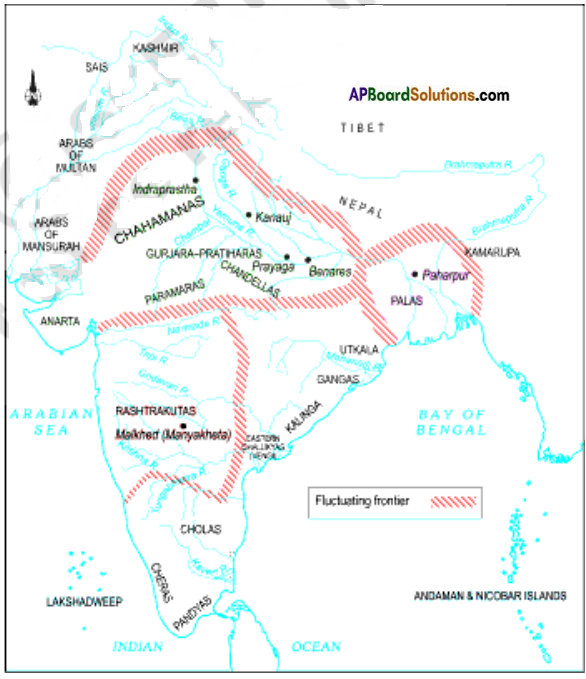SCERT AP Board 7th Class Social Solutions 11th Lesson New Kings and Kingdoms Textbook Questions and Answers.
AP State Syllabus 7th Class Social Studies Solutions 11th Lesson New Kings and Kingdoms
7th Class Social Studies 11th Lesson New Kings and Kingdoms Textbook Questions and Answers
Improve Your Learning
Question 1.
Who were the parties involved in the “tripartite struggle”?
Answer:
Rulers belonging to the Gurjara-Pratihara, Rashtrakuta and Pala dynasties fought for control over Kanauj. These three were the parties involved in the ‘tripartite struggle’.
Question 2.
What were the qualifications to be a member of a committee of the sabha in the Chola empire?
Answer:
Inscriptions and texts
All those who wish to become members of the sabha should be owners of the land from which land revenue is collected. They should have their own homes. They should be between 35 and 70 years of age. They should have knowledge of the Vedas. They should be well-versed in administrative matters and be honest. If anyone has been a member of any committee in the last three years, he cannot become a member of another committee.
Anyone who has not submitted his accounts, including his relatives, cannot contest the elections.
![]()
Question 3.
What were the two major cities under the control of the Chahamanas?
Answer:
Delhi and Ajmer were the two major cities under the control of the Chahamanas.
Question 4.
How did the Rashtrakutas become powerful?
Answer:
The Rasthtrakuta kings used the resources to finance the king’s establishment, as well as for the construction of temples and forts. They were also used to fight wars, which were in turn expected to lead to the acquisition of wealth in the form of plunder and access to land as well as trade routes. Close relatives of the king held higher positions. They often shared power with their ‘Samanthas’ as well as with associations of peasants, traders and brahmins. Thus they became powerful.
Question 5.
What did the new dynasties do to gain acceptance?
Answer:
The new dynasties performed some kinds of Yagnas and Yagas to gain acceptance.
Question 6.
What kind of irrigation works were developed in the Tamil region?
Answer:
Canal irrigation and well irrigation were developed in the Tamil region.
Question 7.
What were the activities associated with Chola temples? (OR)
Explain the importance of temples during the period of Cholas.
Answer:
Chola temples often became the nuclei of settlements that grew around them. These were centres of craft production. Temples were also endowed with land by rulers as well as by others. The produce of this land went into maintaining all the specialists who worked at the temple and very often lived near it – priests, garland makers, cooks, sweepers, musicians, dancers, etc. In other words, temples were not only places of worship; they were the hub of economic, social and cultural life as well.
![]()
Question 8.
Contrast the ‘elections’ in Uttaramerur with present-day panchayat elections.
Answer:
Whatever may be the election procedure the requirements of a candidate to contest in the election was so far better than our Panchayat elections in the following aspects.
- Age
- Knowledge
- Honesty
- Declaration of own wealth.
Question 9.
Collect the pictures of ancient temples and make an album.
Answer:

Question 10.
Read the first two paragraphs under the title ‘Agriculture and Irrigation’ from pages 104 and 105 and comment on them.
Answer:
Agriculture and Irrigation
Many of the achievements of the Cholas were made possible through new developments in agriculture. Look at Map 2 again. Notice that the river Kaveri branches off into several small streams before emptying into the Bay of Bengal. These streams overflow frequently, depositing fertile soil on their banks. Water from the streams also provides the necessary moisture for agriculture, particularly the cultivation of rice.
Although agriculture had developed earlier in other parts of Tamil Nadu, it was only from the fifth or sixth century that this area was opened up for large-scale cultivation. Forests had to be cleared in some regions; the land had to be levelled in other areas. In the delta, region embankments had to be built to prevent flooding and canals had to be constructed to carry water to the fields. In many areas, two crops were grown in a year.
Answer:
There was a tremendous agrarian expansion during the rule of the imperial Chola Dynasty all over Tamilnadu and particularly in Kaveri Basin.
They built many tanks to irrigate the agricultural lands. The main crop was Paddy. Large scale cultivation was started in 5/6th centuries AD.
Forests were cleared to increase the land for cultivation.
Necessary preventive steps were taken to control floods. Two crops were grown in many areas.
![]()
Project Work
Question 1.
Look at Map and find out whether there were any kingdoms in Andhra Pradesh.

Answer:
Student Activity.
Question 2.
Compare the temple shown in this chapter with any present-day temple in your neighbourhood.
Answer:
When compared to the temples shown in this chapter “New Kings and Kingdoms, the present-day temples are small in size and are coloured.
![]()
Question 3.
Find out more about taxes that are collected at present. Are these in cash, kind or labour services?
Answer:
The taxes collected m nowadays are in cash only. They are income tax, sales tax, service tax etc.